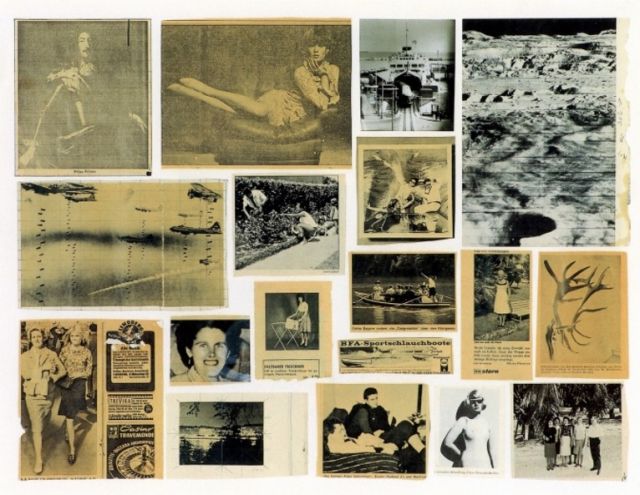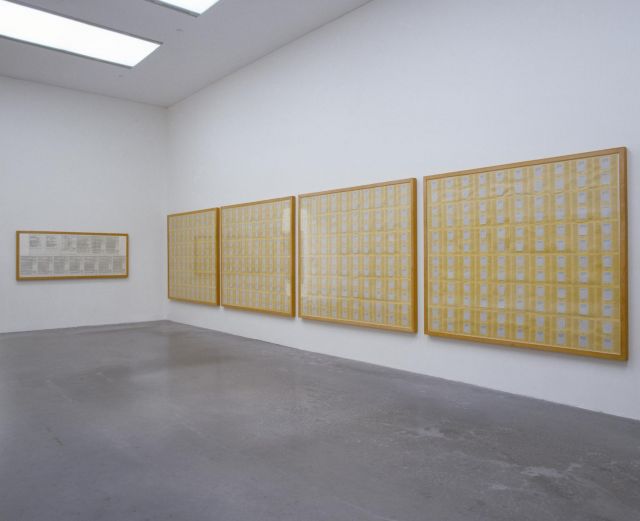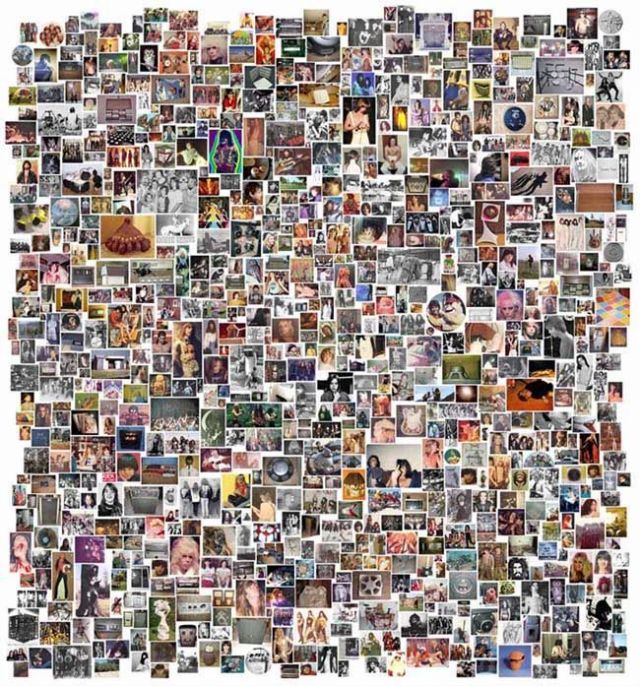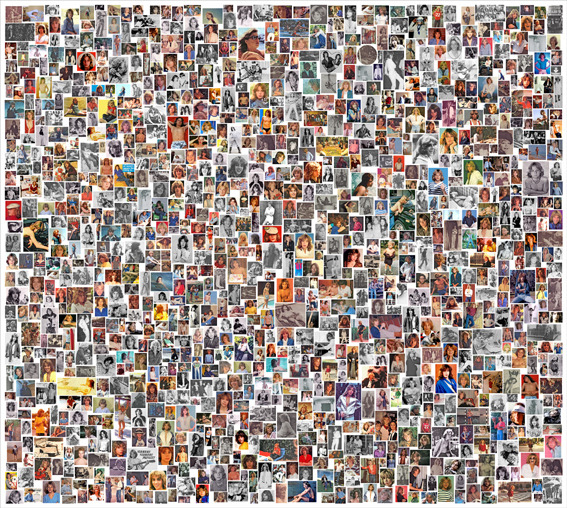Wednesday Investigation 10: Gerhard Richter [Part II], Hanne Darboven, and information as art
On cyberpunk aesthetics, Gerhard Richter, Hanne Darboven, and the 500 books written by an eighteenth century German political prisoner
I was a teenage cyberpunk.
I could have been a better one: even though William Gibson's classic cyberpunk "Sprawl trilogy" was released in the 1980s, when I was a teenager, I didn't get around to reading it until the late 90s, when I was finishing up graduate school. But my freshman year in college I got my hands on a copy of Mark Leyner's My Cousin, My Gastroenterologist, a postmodern cult classic heavily cut with doses of cyberpunk imagery, and when the magazine Mondo 2000 released their cyberpunk lifestyle bible, A User's Guide to the New Edge, in 1992, I pored over it obsessively enough that twenty or so years later I would identify it as one of my "fundamental texts."
One of the most fundamental bits was a passage quoted from science fiction author Rudy Rucker's 1986 essay, "What is Cyberpunk?" In that essay, Rucker suggests that, culturally speaking, we were in the middle of a process of rethinking social capital: that questions like "Who do you know?" or "Do you talk like my old friends?" were less interesting, to cyberpunk readers and writers, than questions like "How fast are you? How dense?" (The passage originates in Rucker). As a geeky teen who didn't have much in the way of valuable social connections, but who had amassed a fairly decent collection of weird tidbits of knowledge, I was helplessly drawn to the idea that having a robust bank of information at your disposal essentially made you cool. And so I worked hard--and still do!--to develop a "dense" information storehouse. Although I usually attribute the inspiration behind the notecard index that fuels this newsletter to my having read Joan Didion's essay "On Keeping a Notebook" (it's also on that "fundamental texts" list), I was probably equally motivated by this idea of Rucker's.
And I've never lost my attraction to things that are "fast" and "dense," which has extended to an interest in the aesthetics of information. Not just an interest in people who design beautiful infographics--though if you haven't seen W. E. B. Du Bois' groundbreaking data visualizations of Black life, check them out--but also an interest in "fine artists" who use large quantities of information in their work. This is how Gerhard Richter ended up in my notecard index: not for his painting--which is what we began discussing last week--but for his work Atlas, which has been described (by art critic Lynn Herbert, I believe) as "a vast framed archive of approximately 4,000 images including snapshots, sketches, postcards, and clippings from magazines that have served as a kind of database or 'atlas' of memories and visual inspiration."

In a 2014 essay, "The Atlas of Affect," critic and novelist Teju Cole puts Atlas (and other works like it, including an important precursor, Aby Warburg's Mnemosyne Atlas, from 1924) in a tradition of "dialectical images"--placing "images in conversation with other images." This opens into a wide range of fascinating aesthetic questions. If you're the artist placing the images--orchestrating the conversation, as it were--how do you decide what gets included? What gets left out? Richter has said “In the beginning I tried to accommodate everything there that was somewhere between art and garbage and that somehow seemed important to me and a pity to throw away.” The terrain that lies between the poles of "art and garbage" is obviously pretty wide--impossible to cover exhaustively--and even once you've made your decisions about inclusion, you only progress to further questions: how should the pieces be arranged, juxtaposed, rearranged?
My note on Richter also contains reference to Hanne Darboven, a German artist, writer, and composer (and also a friend and contemporary of Richter's). Darboven produced her own "atlas-like" work, Kulturgeschichte [1880-1983], which critic Dan Adler describes as an "encyclopedic installation consisting of 1,590 works on paper and 19 sculptural objects," including "autobiographical documents, postcards, pinups of film and rock stars, documentary references to the first and second world wars, geometric diagrams for textile weaving, a sampling of New York doorways, illustrated covers from news magazines, the contents of an exhibition catalogue devoted to postwar European and American art, a kitschy literary calendar, and extracts from some of Darboven's earlier works." Darboven's choice to present this work in a series of repetitive diptychs--dramatically framed, no less--encourages the viewer to think about Darboven's methods of organization.

Art critic Jennifer Krasinski, writing on Kulturgeschichte for the Village Voice in 2017, pursues this thread, noting that one of Darboven's central aesthetic concerns is "[o]rder, and how to make it, and what to make of it." According to Krasinski, some of Darboven's earliest works--the "Konstruktionen," a series of abstract drawings on graph paper--are drawn algorithmically, generated by a series of equations. In 1981, explaining the lure of a formal systems of organization, deployed aesthetically, she remarked "everything else would be boundless."
This tantalizingly implies the existence of a formal system undergirding Kulturgeschichte, although if there is one, I don't know what it is (Krasinski carefully notes patterns and repetitions that she observes in the work, but she ultimately remarks that the work resists the attempt to be reduced to an order, that it "aborts sense.")
As I researched this, I also stumbled upon a piece by Darboven entitled Card-Index: Filing Cabinet (made in two parts in 1975). Here's Part Two, at the Tate:

Being a lover of card indexes, I scrutinized this picture, desperate to figure out what Darboven might have recorded on her own notecards. The answer, once I found it (in Briony Fer's The Infinite Line: Re-making Art After Modernism), was not tremendously rewarding--the cards that comprise this work contain only extended numerical sequences, possibly the output of more equations, another hidden system of order. However, I was rather pleased to learn that Darboven dedicated the work to Johan Jakob Moser, an 18th century German jurist (and political prisoner!) who invented his own filing system.
I took a peek in Moser's biography (Mack Walker's Johann Jakob Moser and the Holy Roman Empire of the German Nation) to learn a bit more:
"Every working day Moser sat down before an array of boxes, each a foot square and four inches high, and each filled with rows of four-by-six slips separated into rubrics by labeled upright cards. His learning was keyed there in compartments. Whatever he found in his reading that seemed valuable was abstracted or copied and its source identified, placed upon the slips, and filed under the appropriate rubric. When he came to write a book, he thought out what headings it ought to include, and in what order, and arranged the rubrics accordingly. Then he went through his slips chapter by chapter, paragraph by paragraph [...], numbered them in serial order, and sent them to the printer."
Moser used this system to compose between 500 and 600 books--how's that for "fast and dense?" Their quality, perhaps unsurprisingly, may have been uneven: Walker wryly notes that Moser "never had to, and almost never chose to, think about intrinsic or tangential relations between his facts, or how the bits might fit dependently into a whole," leading readers--"anybody seeking some theory or theme to Moser's jurisprudence"--to struggle with "the abrupt incongruity" of Moser's system of ordering.
Walker notes that the books are "disorderly," "preposterous," "absurd." And yet, this may make him a figure for our moment after all. "After all," Darboven has written, "day in, day out, we deal with the sense and nonsense of things." And as the world of "things" or grows, and the sheer amount of visual material produced each day begins to strain our attempts at artistic organization of that material, there's certainly the temptation to simply forget the connective tissue and just rely on techniques of sheer amassing. The work of Steven Shearer takes this to mindboggling extremes:


We see a version of this in the literary world, too, which grows ever more appreciative of writers deploying the technique of "the fragment." The poet Edmond Jabès has argued that the fragment yields access to "the infinite," and Rosmarie Waldrop has argued that "it is our way of apprehending anything," that even our most inclusive views are "mosaics." And I don't think they're wrong. So maybe the time is right for us to embrace Moser's technique: it might be the right technique for an overcrowded day and age, and we may yet come to consider him the patron saint of this project after all. Keep an eye out for the backlash, though.
Further reading: Collect the WWWorld: The Artist as Archivist in the Internet Age; Sven Spieker's The Big Archive: Art from Bureaucracy.
-JPB, Dedham, MA, June 23 // (revised Wednesday, June 24)
![Wednesday Investigations [2:15]: Blind spots, part two](/content/images/size/w960/2025/05/jeph-jerman.jpg)
![Wednesday Investigations [2:14]: Blind spots](/content/images/size/w960/2025/05/takehisa-kosugi.jpg)